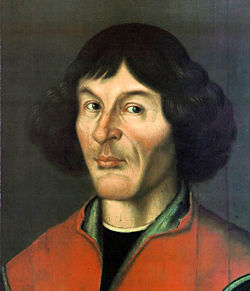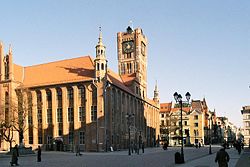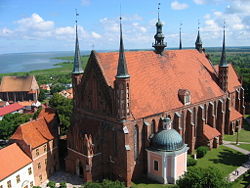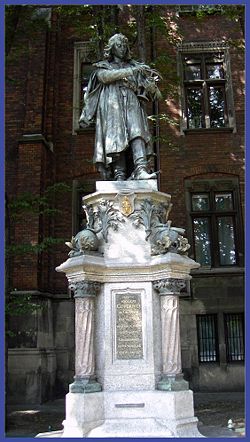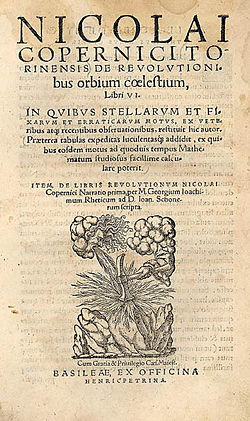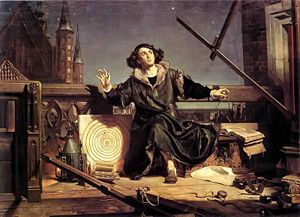Nicolaus Copernicus (February 19, 1473 â May 24, 1543) was one of the great polymaths of his age. He was a mathematician, astronomer, jurist, physician, classical scholar, governor, administrator, diplomat, economist, and soldier. Amid his extensive accomplishments, he treated astronomy as an avocation. However, it is for his work in astronomy and cosmology that he has been remembered and accorded a place as one of the most important scientific figures in human history. He provided the first modern formulation of a heliocentric (Sun-centered) theory of the solar system in his epochal book, De revolutionibus orbium coelestium (On the Revolutions of the Heavenly Spheres).
That change, often known as the Copernican revolution, had important and far-reaching implications for not only science and cosmology but also theology, philosophy, and culture, and for the relationship between religion and science. Copernicus' concept marked a scientific revolution. It has been equated it with the initiation of "the scientific revolution."
Biographical sketch
Copernicus was born in 1473 in ToruĆ (Thorn). On account of geographical and historical uncertainties, it remains a matter of dispute whether Copernicus was German or Polish.[1] A modern view is that he was an ethnically German Pole.
When Copernicus was ten years old, his father, a wealthy businessman and copper trader, died. Little is known of his mother, Barbara Watzenrode, who appears to have predeceased her husband. Copernicus' maternal uncle, Lucas Watzenrode, a church canon (an administrative position below that of bishop) and later prince-bishop governor of Warmia, reared him and his three siblings after the death of his father. His uncle's position helped Copernicus in the pursuit of a career within the church, enabling him to devote time for his astronomy studies. Copernicus had a brother and two sisters:
- Andreas, who became a canon at Frombork (Frauenburg)
- Barbara, who became a Benedictine nun
- Katharina, who married businessman and city councilor Barthel Gertner
In 1491, Copernicus enrolled at the Jagiellonian University in KrakĂłw, where he probably encountered astronomy for the first time, taught by his teacher Albert Brudzewski. This science soon fascinated him, as shown by his books, which were later carried off as war booty by the Swedes during "The Deluge," to the Uppsala University Library. After four years at KrakĂłw, followed by a brief stay back home at ToruĆ, he went to Italy, where he studied law and medicine at the universities of Bologna and Padua. His bishop-uncle financed his education and wished for him to become a bishop as well. However, while studying canon and civil law at Ferrara, Copernicus met the famous astronomer, Domenico Maria Novara da Ferrara. Copernicus attended his lectures and became his disciple and assistant. The first observations that Copernicus made in 1497, together with Novara, are recorded in Copernicus' epochal book, De revolutionibus orbium coelestium (On the Revolutions of the Heavenly Spheres).
In 1497, Copernicus' uncle was ordained Bishop of Warmia, and Copernicus was named a canon at Frombork (Frauenburg) Cathedral, but he waited in Italy for the great Jubilee of 1500. Copernicus went to Rome, where he observed a lunar eclipse and gave some lectures in astronomy or mathematics.
It is uncertain whether Copernicus was ordained a priest; he may only have taken minor orders, which sufficed for assuming a chapter canonry. It appears that he visited Frombork in 1501. As soon as he arrived, he requested and obtained permission to return to Italy to complete his studies at Padua (with Guarico and Fracastoro) and at Ferrara (with Giovanni Bianchini), where in 1503 he received his doctorate in canon law. It has been supposed that it was in Padua that he encountered passages from Cicero and Plato about opinions of the ancients on the movement of the Earth, and formed the first intuition of his own future theory. His collection of observations and ideas pertinent to his theory began in 1504.
Having left Italy at the end of his studies, he came to live and work at Frombork. Some time before his return to Warmia, he received a position at the Collegiate Church of the Holy Cross in WrocĆaw (Breslau), Silesia, which he resigned from a few years before his death. He made astronomical observations and calculations through the rest of his life, but always in his spare time and never as a profession.
Copernicus worked for years with the Prussian Diet on monetary reform and published some studies about the value of money. As governor of Warmia, he administered taxes and dealt out justice. It was at this time (beginning in 1519, the year of Thomas Gresham's birth) that Copernicus came up with one of the earliest iterations of the theory now known as Gresham's Law. During these years, he also traveled extensively on government business and as a diplomat on behalf of the prince-bishop of Warmia.
In 1514, he made his Commentariolusâa short, handwritten text describing his ideas about the heliocentric hypothesisâavailable to friends. Thereafter, he continued gathering evidence for a more detailed work. During the war between the Teutonic Order and the Kingdom of Poland (1519â1524), Copernicus successfully defended Allenstein (Olsztyn) at the head of royal troops besieged by the forces of Albert of Brandenburg.
In 1533, Albert Widmanstadt delivered a series of lectures in Rome, outlining Copernicus' theory. These lectures were watched with interest by several Catholic cardinals, including Pope Clement VII. By 1536, Copernicus' work was already in definitive form, and some rumors about his theory had reached educated people all over Europe. From many parts of the continent, Copernicus received invitations to publish. In a letter dated Rome, November 1, 1536, Cardinal Nicola Schönberg of Capua wrote, asking Copernicus to communicate his ideas more widely and requesting a copy for himself: "Therefore, learned man, without wishing to be inopportune, I beg you most emphatically to communicate your discovery to the learned world, and to send me as soon as possible your theories about the Universe, together with the tables and whatever else you have pertaining to the subject." Some have suggested that this note may have made Copernicus leery of publication, while others have suggested that this letter indicates that the Church wanted to ensure that his ideas were published.
Despite the insistence of many, Copernicus kept delaying the final publication of his book, probably out of fear of criticism for his revolutionary work by the establishment. He was still completing his masterpiece (even if he was not convinced that he wanted to publish it) when in 1539, Georg Joachim Rheticus, a great mathematician from Wittenberg, arrived in Frombork. Philipp Melanchthon had arranged for Rheticus to visit several astronomers and study with them. Rheticus became a disciple of Copernicus' and stayed with him for two years, during which he wrote a book, Narratio prima, outlining the essence of the theory.
In 1542, in Copernicus' name, Rheticus published a treatise on trigonometry (later included in the second book of De revolutionibus). Under strong pressure from Rheticus, and having seen that the first general reception of his work had been favorable, Copernicus finally agreed to give the book to his close friend Tiedemann Giese, bishop of CheĆmno (Kulm), to be delivered to Rheticus for printing in Nuremberg (NĂŒrnberg).
Legend says that the first printed copy of De revolutionibus was placed in Copernicus' hands on the day he died, so that he could take farewell of his opus vitae. He supposedly woke from a stroke-induced coma, looked at his book, and died peacefully.
Copernicus was buried in Frombork Cathedral. In August 2005, a team of archaeologists led by Jerzy GÄ ssowski, head of an institute of archeology and anthropology in PuĆtusk, discovered what they believe to be Copernicus' grave and remains, after scanning beneath the cathedral floor. The find came after a year of searching, and the discovery was announced only after further research, on November 3, 2005. GÄ ssowski said he was "almost 100 percent sure it is Copernicus." Forensics experts used the skull to reconstruct a face that closely resembled the featuresâincluding a broken nose and a scar above the left eyeâon a self-portrait. The experts also determined that the skull had belonged to a man who had died at about age 70âCopernicus' age at the time of his death. The grave was in poor condition, and not all the remains were found. The archaeologists hoped to find relatives of Copernicus in order to attempt DNA identification.
The Copernican heliocentric system
Earlier theories
Much has been written about earlier heliocentric theories. Philolaus (fourth century B.C.E.) was one of the first to hypothesize movement of the Earth, probably inspired by Pythagoras' theories about a spherical globe.
In the third century B.C.E., Aristarchus of Samos had developed some theories of Heraclides Ponticus, to propose what was, so far as is known, the first serious model of a heliocentric solar system. His work about a heliocentric system has not survived, so one may only speculate about what led him to his conclusions. It is notable that, according to Plutarch, a contemporary of Aristarchus, accused him of impiety for "putting the Earth in motion."
Aryabhata of India was the first to have noted that the Earth is round. He says, "Bhumukha sarvato golah" (Earth is round). Furthermore, Bhaskara I anticipated Copernicus' discoveries by about one thousand years. The work of the fourteenth-century Arab astronomer Ibn al-Shatir contains findings similar to those of Copernicus, and it has been suggested that Copernicus might have been influenced by them.
Copernicus cited Aristarchus and Philolaus in an early manuscript of his book that survives, stating: "Philolaus believed in the mobility of the Earth, and some even say that Aristarchus of Samos was of that opinion." For reasons unknown, he struck this passage before publication of his book.
Inspiration came to Copernicus not from observation of the planets but from reading two authors. In Cicero, he found an account of the theory of Hicetas. Plutarch provided an account of the Pythagoreans Heraclides Ponticus, Philolaus, and Ecphantes. These authors had proposed a moving Earth that revolved around a central Sun. In addition, it has been claimed that in developing the mathematics of heliocentrism, Copernicus drew on not just the Greek but also the Arabic tradition of mathematics, especially the work of Nasir al-Din al-Tusi and Muâayyad al-Din al-âUrdi.
The Ptolemaic system
As Copernicus was developing his heliocentric model, the prevailing theory in Europe was that created by Ptolemy in his Almagest, dating from about 150 C.E. The Ptolemaic system drew on many previous theories that viewed Earth as a stationary center of the universe. Stars were embedded in a large outer sphere, which rotated relatively rapidly, while the planets dwelt in smaller spheres betweenâa separate one for each planet. To account for certain anomalies, such as the apparent retrograde motion of many planets, a system of epicycles was used, in which a planet was thought to revolve around a small axis while also revolving around the Earth. Some planets were assigned "major" epicycles (for which retrograde motion could be observed) and "minor" epicycles (that simply warped the overall rotation).
Ptolemy's unique contribution was the idea of an equant. This complicated addition specified that, when measuring the Sun's rotation, one sometimes used the central axis of the universe, but sometimes one set at a different location. This had an overall effect of making certain orbits "wobble," a fact that greatly bothered Copernicus (because such wobbling rendered implausible the idea of material "spheres" in which the planets rotated). In the end, astronomers could still not get observation and theory to match up exactly. In Copernicus' day, the most up-to-date version of the Ptolemaic system was that of Peurbach (1423-1461) and Regiomontanus (1436-1476).
Copernican theory
Copernicus' major theory was published in De revolutionibus orbium coelestium in 1543, the year of his death. The book marks the beginning of the shift away from a geocentric view of the universe.
Copernicus held that the Earth is another planet revolving around the fixed Sun once a year, and turning on its axis once a day. He arrived at the correct order of the known planets and explained the precession of the equinoxes correctly by a slow change in the position of the Earth's rotational axis. He also gave a clear account of the cause of the seasons: that the Earth's axis is not perpendicular to the plane of its orbit. He added another motion to the Earth, by which the axis is kept pointed throughout the year at the same place in the heavens; since Galileo Galilei, it has been recognized that for the Earth not to point to the same place would have been a motion.
Copernicus also replaced Ptolemy's equant circles with more epicycles. This is the main source of the statement that Copernicus' system had even more epicycles than Ptolemy's. With this change, Copernicus' system showed only uniform circular motions, correcting what he saw as the chief inelegance in Ptolemy's system. Although Copernicus put the Sun at the center of the celestial spheres, he placed it near but not at the exact center of the universe.
The Copernican system did not have any greater experimental support than Ptolemy's model. Copernicus was aware of this and could not present any observational "proof" in his manuscript, relying instead on arguments about what would be a more complete and elegant system. From publication until about 1700, few astronomers were fully convinced of the Copernican system, though the book was relatively widely circulated (around five hundred copies are known to still exist, which is a large number by the scientific standards of the time). Many astronomers, however, accepted some aspects of the theory at the expense of others, and his model did have a large influence on later scientists such as Galileo and Johannes Kepler, who adopted, championed, and (especially in Kepler's case) sought to improve it. Galileo's viewing of the phases of Venus produced the first observational evidence for Copernicus' theory.
The Copernican system can be summarized in seven propositions, as Copernicus himself collected them in a Compendium of De revolutionibus that was found and published in 1878. These propositions are:
- There is no one center in the universe.
- The Earth's center is not the center of the universe.
- The center of the universe is near the Sun.
- The distance from the Earth to the Sun is imperceptible compared with the distance to the stars.
- The rotation of the Earth accounts for the apparent daily rotation of the stars.
- The apparent annual cycle of movements of the Sun is caused by the Earth revolving around the Sun.
- The apparent retrograde motion of the planets is caused by the motion of the Earth, from which one observes.
Whether these propositions were "revolutionary" or "conservative" was a topic of debate in the late twentieth century. Thomas Kuhn argued that Copernicus merely transferred "some properties to the Sun many astronomical functions previously attributed to the Earth." Other historians have since argued that Kuhn underestimated what was "revolutionary" about Copernicus' work, and emphasized the difficulty Copernicus would have had in putting forward a new astronomical theory relying alone on simplicity in geometry, given that he had no experimental evidence.
De revolutionibus orbium coelestium
Copernicus' major work, De revolutionibus, was the result of decades of labor. When published, it contained a preface by Copernicus' friend, Andreas Osiander, a Lutheran theologian. Osiander stated that Copernicus wrote his heliocentric account of the Earth's movement as a mere mathematical hypothesis, not as an account that contained truth or even probability. This was apparently written to soften any religious backlash against the book.
De revolutionibus began with a letter from Copernicus' (by then deceased) friend Nicola Schönberg, the Archbishop of Capua, urging him to publish his theory. Then, in a lengthy introduction, Copernicus dedicated the book to Pope Paul III, explaining his ostensible motive in writing the book as relating to the inability of earlier astronomers to agree on an adequate theory of the planets, and noting that if his system increased the accuracy of astronomical predictions, it would allow the Church to develop a more accurate calendar. At that time, a reform of the Julian Calendar was considered necessary and was one of the major reasons for Church funding of astronomy.
The work itself was then divided into six books:
- General vision of the heliocentric theory, and a summarized exposition of his idea of the World
- Mainly theoretical, presents the principles of spherical astronomy and a list of stars (as a basis for the arguments developed in subsequent books)
- Mainly dedicated to the apparent motions of the Sun and to related phenomena
- Description of the Moon and its orbital motions
- Concrete exposition of the new system
- Concrete exposition of the new system
Impact of the Copernican Revolution
Copernicus' formulation of heliocentric cosmology, the view that the Sun is at the center of the universe, stands in contrast to Ptolemy's geocentric cosmology, in which the Earth was placed at the center. The heliocentric model is almost universally considered to be one of the most important scientific hypotheses in history, as well as being of extraordinary importance in the history of human knowledge altogether. It came to mark the starting point of modern astronomy and modern science, and it is often known as the Copernican revolution; it is considered the start of "the scientific revolution."[2].
Besides its importance to science, astronomy, and cosmology, the Copernican revolution also had profound implications for religion, theology, and philosophy. Jose Wudka (1998) described it thus:
It is hard to [over]estimate the importance of this work: it challenged the age-long views of the way the universe worked and the preponderance of the Earth and, by extension, of human beings. ... All the reassurances of the cosmology of the Middle Ages were gone, and a new view of the world, less secure and comfortable, came into being. Despite these 'problems' and the many critics the model attracted, the system was soon accepted by the best minds of the time such as Galileo.[3]
The construction and/or acceptance of Ptolemy's geocentric cosmology had been based on a number of assumptions and arguments that were philosophical and theological in nature. First was Aristotle's notion that things are naturally fixed and unmoving unless something moves them. A second assumption was that the place of human beings as children of Godâan assertion made by both Jewish and Christian doctrineâand thus the highest or most important beings in the cosmos (except for those who held angels to be higher than humans), requires that Earth as the dwelling place of humans be at the center of the universe. A third assumption was that philosophy, logic, and theology are paramount in importance, superior to natural science and its methods. A fourth assumption had to do with falling bodies: the Ptolemaic view had held that if the Earth were not the center of the cosmos, then things would not fall to Earth when thrown into the sky and that the Earth itself would fall toward whatever was the center. A fifth was that, if the Earth moved, then things thrown into air above the Earth would be "left behind" and not fall to Earth as the Earth moved. A sixth was that, if the Earth moved, this would be a contradiction of scripture, which says that Joshua commanded the Sun and Moon (not the Earth) to be still and cease moving across the sky (Josh 10: 12-13).
Today we know that each of those assumptions was incorrect. We now know that the principle of inertia means that moving things will continue to move unless some force stops them. Second, we have come to realize that the Earth's position needs to be determined by scientific methods, not by religious doctrine or philosophical arguments. At the same time, it needs to be understood that the place of humans in the universe as the children of God does not depend on the physical location of the Earth, or the size or prominence of the Sun, or the prominence of the Milky Wayâthe galaxy in which Earth is situatedâin the cosmos. Falling bodies move toward whatever attracts them gravitationally; moreover things thrown up into the air from Earth are already part of Earth's inertial system, so they move as the Earth moves and fall back to earth having moved as the Earth moved during their flight. The claim in Joshua may be interpreted as a figure of speech rather than as a literal event.
The notion of a "Copernican Revolution" became important in philosophy as well as science. For one thing, philosophy of science had to recognize and account for the fact that science does not grow in a smooth and continuous pattern. Instead, there are occasional revolutions in which one scientific pattern or paradigm is overthrown by another. Later, in the twentieth century, American historian and philosopher of science Thomas Kuhn made scientific revolutions and the notion of a "paradigm" and "paradigm shift" central points in his monumental and highly influential work, The Structure of Scientific Revolutions. German philosopher Immanuel Kant captured the transcendent rationalism of the Copernican revolution, postulating that it was human rationality that was the true interpreter of observed phenomena. In addition, he referred to his own work as being a "Copernican revolution" in philosophy. More recent philosophers, too, have found continuing validity and philosophical meaning in Copernicanism.
The Copernican heliocentric system was rejected for theological and philosophical reasons by the Catholic and Lutheran churches of his day. This may not have been the first time in human history when a clash between religion and science occurred, but it was the most significant one up to that time. That clashâoften referred to as a warfare between science and religionâcontinues in some form, with sometimes waxing and sometimes waning intensity, to this day. An important result of the Copernican revolution was to encourage scientists and scholars to take a more skeptical attitude toward established dogma.
Based on the work of Copernicus and others, some have argued that "science could explain everything attributed to God," and that there was no need to believe in an entity (God) who grants a soul, power, and life to human beings. Others, including religious scientists, have taken the view that the laws and principles of nature, which scientists strive to discover, originated from the Creator, who works through those principles. Copernicus himself continued to believe in the existence of God.
Copernicanism was also used to support the concept of immanenceâthe view that a divine force or divine being pervades all things that exist. This view has since been developed further in modern philosophy. Immanentism can also lead to subjectivism, to the theory that perception creates reality, that underlying reality is not independent of perception. Thus some argue that Copernicanism demolished the foundations of medieval science and metaphysics.
A corollary of Copernicanism is that scientific law need not be directly congruent with appearance or perception. This contrasts with Aristotle's system, which placed much more importance on the derivation of knowledge through the senses.
Quotes
- "Of all discoveries and opinions, none may have exerted a greater effect on the human spirit than the doctrine of Copernicus. The world had scarcely become known as round and complete in itself when it was asked to waive the tremendous privilege of being the center of the universe. Never, perhaps, was a greater demand made on mankindâfor, by this admission, so many things vanished in mist and smoke! What became of our Eden, our world of innocence, piety and poetry; the testimony of the senses; the conviction of a poeticâreligious faith? No wonder his contemporaries did not wish to let all this go and offered every possible resistance to a doctrine which in its converts authorized and demanded a freedom of view and greatness of thought so far unknown, indeed not even dreamed of."
Copernicus:
- "For I am not so enamored of my own opinions that I disregard what others may think of them. I am aware that a philosopher's ideas are not subject to the judgment of ordinary persons, because it is his endeavor to seek the truth in all things, to the extent permitted to human reason by God. Yet I hold that completely erroneous views should be shunned. Those who know that the consensus of many centuries has sanctioned the conception that the Earth remains at rest in the middle of the heaven as its center would, I reflected, regard it as an insane pronouncement if I made the opposite assertion that the Earth moves.
- "For when a ship is floating calmly along, the sailors see its motion mirrored in everything outside, while on the other hand they suppose that they are stationary, together with everything on board. In the same way, the motion of the Earth can unquestionably produce the impression that the entire universe is rotating.
- "Therefore alongside the ancient hypotheses, which are no more probable, let us permit these new hypotheses also to become known, especially since they are admirable as well as simple and bring with them a huge treasure of very skillful observations. So far as hypotheses are concerned, let no one expect anything certain from astronomy, which cannot furnish it, lest he accept as the truth ideas conceived for another purpose, and depart from this study a greater fool than when he entered it. Farewell."
Declaration of the Polish Senate issued on June 12, 2003:
- "At the time of five hundred thirty anniversary of birth and four hundred sixty date of death of MikoĆaj Kopernik, the Senate of Republic of Poland expresses its highest respect and praise for this exceptional Pole, one of the greatest scientists in the history of the world. MikoĆaj Kopernik, world famous astronomer, author of the breakthrough work "O obrotach sfer niebieskich," is the the one who "Held the Sun and moved Earth." He distinguished himself for the country as exceptional mathematician, economist, lawyer, doctor, and priest, as well as defender of the Olsztyn Castle during Polish-Teutonic war. May memory about his achievements last and be a source of inspiration for future generations."
Notes
- â K. Stuart Parkes, Understanding Contemporary Germany (London: Routledge, 1997, ISBN 0415141230), xxi.
- â David Banach (2006), Timeline of the Scientific Revolution. Retrieved June 29, 2007.
- â Jose Wudka (1998), The Copernican Revolution, Department of Physics and Astronomy, University of California Riverside. Retrieved June 29, 2007.
Bibliography
- Works of Copernicus
- The complete works of Copernicus are collected in On the Revolutions, ed. and trans. by Edward Rosen (1978, reissued 1992), and Minor Works, ed. and trans. by Edward Rosen and Erna Hilfstein (1985, reissued 1992). Three Copernican Treatises, trans. by Edward Rosen (1971) contains, in addition, a biography and a bibliography of works on Copernicus from 1939-70.
- Biographies of Copernicus
- Adamczewski, Jan, and Edward J. Piszek. Nicolaus Copernicus and His Epoch. Scribner, 1974. ISBN 978-0684138398
- Rosen, Edward. Copernicus and the Scientific Revolution. Malabar, FL: Krieger, 1884. ISBN 978-0898745733
- Works About Copernicus and His Work
- Armitage, Angus. The World of Copernicus. New York, NY: Mentor Books, 1951. ISBN 0846409798
- Blumenberg, Hans. The Genesis of the Copernican World. The MIT Press, 1989. ISBN 978-0262521444
- Dreyer, J. L. E. A History of Astronomy from Thales to Kepler. Dover Publications, 2011. ISBN 978-0486600796
- Gingrich, Owen. The Eye of Heaven: Ptolemy, Copernicus, Kepler. Springer, 1997. ISBN 978-0883188637
- Gingrich, Owen. The Book Nobody Read. Penguin Books, 2004. ISBN 0143034766
- Goodman, David C., and Colin A. Russell (eds.). The Rise of Scientific Europe, 1500-1800. Dunton Green, Sevenoaks, Kent: Hodder & Stoughton: The Open University, 1991. ISBN 034055861X
- Hoyle, Fred. Nicolaus Copernicus: An Essay on His Life and Work. Harper & Row, 1973. ISBN 978-0060119713
- Koyre, Alexander. The Astronomical Revolution. Dover Publications, 1992. ISBN 0486270955
- Kuhn, Thomas. The Copernican Revolution: Planetary Astronomy in the Development of Western Thought. Cambridge, MA: Harvard University Press, 1985. ISBN 0674171004
- Kuhn, Thomas. The Structure of Scientific Revolutions. Chicago, IL: The University of Chicago Press, 1996. ISBN 978-0226458083
- Lindberg, David C. (ed.). Science in the Middle Ages. Chicago, IL: University of Chicago Press, 1978. ISBN 978-0226482330
- Nebelsick, Harold P. Circles of God: Theology and Science from the Greeks to Copernicus. Scottish Academic Press, 1985. ISBN 978-0707304489
- Westman, Robert S. (ed.). The Copernican Achievement. Univ of California Press, 1976. ISBN 978-0520028777
External links
All links retrieved June 30, 2025.
- Works by Nicolaus Copernicus. Project Gutenberg
- Stanford Encyclopedia of Philosophy entry
- 'Body of Copernicus' identified â BBC News â Article including image of Copernicus using facial reconstruction based on located skull
- The Copernican Universe from De Revolutionibus
- The text of De Revolutionibus
- (Italian) Copernicus in Bologna
- "Chasing Copernicus: The Book Nobody ReadâWas One of the Greatest Scientific Works Really Ignored?" All Things Considered, National Public Radio
- "Copernicus and his Revolutions" by James Hannam (2003) â A detailed critique of the rhetoric of De Revolutionibus
- "Whose Science is Arabic Science in Renaissance Europe?" by George Saliba â Discusses Copernicus's debt to the Arabic tradition
Credits
New World Encyclopedia writers and editors rewrote and completed the Wikipedia article in accordance with New World Encyclopedia standards. This article abides by terms of the Creative Commons CC-by-sa 3.0 License (CC-by-sa), which may be used and disseminated with proper attribution. Credit is due under the terms of this license that can reference both the New World Encyclopedia contributors and the selfless volunteer contributors of the Wikimedia Foundation. To cite this article click here for a list of acceptable citing formats.The history of earlier contributions by wikipedians is accessible to researchers here:
The history of this article since it was imported to New World Encyclopedia:
Note: Some restrictions may apply to use of individual images which are separately licensed.
